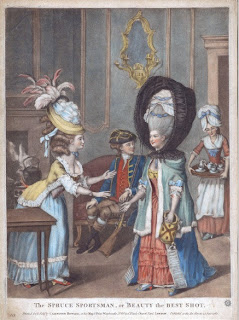As anyone who has followed this blog knows, we NHG love satirical prints from the 18th-19th c. – not only for their droll humor, but also for the insight they provide into the details of everyday life in the past. Yet not even we have dared to dream (and we do dare, quite often) that we could actually see such a scene.
But that's exactly what our excellent friends at the Margaret Hunter Shop of Colonial Williamsburg have been working for much of this year: recreating all the clothes and accessories shown in the print, left: The Spruce Sportsman: or Beauty the best shot (also called A Morning Visit, or The Fashionable Dresses for the Year 1777)by Carrington Bowles.
There are several purposes to the project. The first, of course, is to create these clothes much as any accomplished and style-conscious 18th century English tailor and mantua maker would for his or her customers, using period techniques and materials. Everything is cut and stitched by hand.
Second, the pieces will be used as examples in lectures for an upcoming symposium, Costume Accessories: Head to Toe, to be offered at Colonial Williamsburg in March, 2011. (For more information and to download a registration form, click here.)
Third, and most dramatic of all, the clothing and accessories will be featured in a video presentation to accompany an upcoming exhibition called Fashion Accessories from Head to Toe at the DeWitt Wallace Decorative Arts Museum in Colonial Williamsburg. The figures in The Spruce Sportsman will quite literally come to life in the video by way of costumed interpreters. While the video is still in production, here's a sneak peek behind the scenes, right, showing the actors and actresses in place for the shoot before the green screen, and all dressed in their gorgeous finery. Over the next few days, we'll be sharing close-ups of some of these pieces – beginning with that amazing feathered hat.
(This print may seem familiar for another reason – it's used on the cover of Behind Closed Doors: At Home in Georgian England
Above: The Spruce Sportsman, or Beauty the best shot, by Carrington Bowles, 1777. Collection, Colonial Williamsburg.
Below: Photograph courtesy of the Margaret Hunter Millinery Shop, Colonial Williamsburg.


 One of us --
One of us -- 



10 comments:
I don't understand the purpose of the six foot tall hat covering the five foot tall hat. Was this something they wore in inclement weather to keep their underbonnet dry and clean?
I'd love to see all of this in person though. Amazing.
Caps (the white hat thingie) were always worn by married women. Indoors without anything else on top, outdoors with a hat on top. When you come in from outdoors, you take your hat off, but keep your cap on. The saved you from having to style your hair elaborately, and kept your hair safely out of the face. Also, it could protect hats from hair grease.
Without a cap, you were not properly dressed - modern analogy: Going to an office job barefoot.
The big black hat, a calash, was supposed to protect you from the weather. It's so tall because in the 1770s, hairstyles got too big to fit under a cloak's hood properly. Wearing caps under straw hats can also be quite useful, because hair gets easily entangled in bits of straw sticking out.
Don't take the sizes in the picture too seriously - it's a satirical print, hence exaggerating the fashion to the point of being ridiculous. Most real calashes that you can find in museums today are much smaller.
I just received the mailing for this symposium in Friday's mail. Serendipity! I'm looking forward to your 'teasers' this week for the show. The costumers of Colonial Williamsburg always do such a fabulous job. They are true craftsmen in the old ways.
I hope we will see more of that calesh close-up. I have seen them mentioned in books, but never could imagine what they looked like.
So, did they name the hat after the carriage? Or the carriage after the hat?
Apparently the carriage came first--some sources say that the name was originally French: Caleche, First Known Use in print: 1666
What I appreciate the most about this is that Sportsman is far more interested in the plain serving girl then the fashionable ladies. A man who has his priorities right ;)
I'm always amazed by the height of the hair! I remember having a copy of Cinderella that had illustrations from the 18th century and the hair was huge. I hate to think of all the things that were living in there.
I have not one, but two caleche bonnets coming on Wednesday's blog - the black one from this picture, and a smaller one from the earlier 19th c. But first, tomorrow, will be the feathered hat. :)
I can only imagine how much fun it must have been to work on this project! What a fun and fabulous idea
Post a Comment